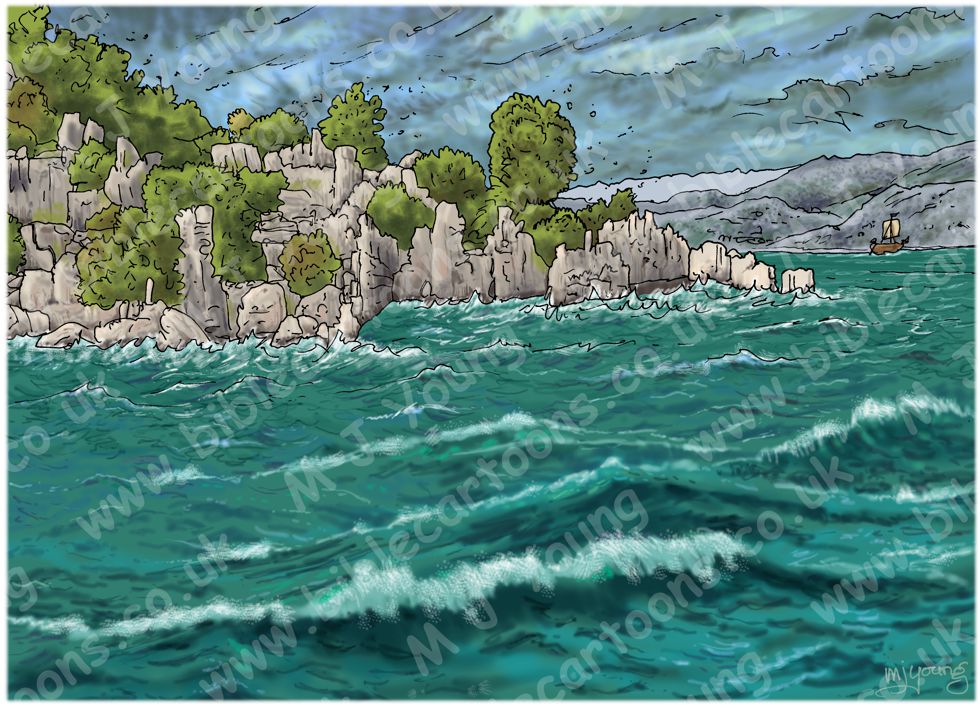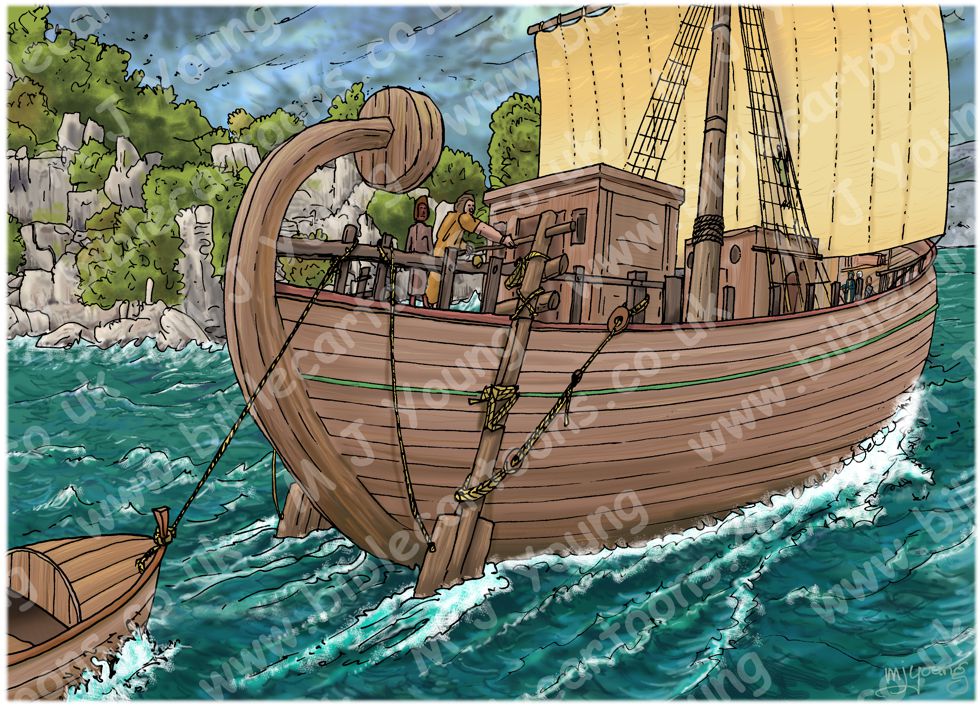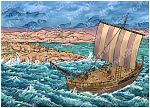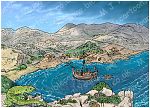Bible Cartoon: Acts 27 - Paul sails for Rome - Scene 05 - Alexandrian ship
Click on Add to cart button below shopping cart.
Purchased Bible Cartoons do not have watermarks. Links to Cartoons provided on email once purchase is completed.Bible Book: Acts
Bible Book Code: 4402700601
Scene no: 5 of 7
Bible Reference & Cartoon Description
Acts 27:6-7a (ANIV)
6 There [in Myra in Lycia] the centurion found an Alexandrian ship sailing for Italy and put us on board. 7a We made slow headway for many days and had difficulty arriving off Cnidus… [When the wind did not allow us to hold our course, we sailed to the lee of Crete, opposite Salmone.]
DRAWING NOTES:
TIME OF DAY:
Unspecified in Bible narrative. I’ve set this scene in the afternoon.
LIGHTING NOTES:
The sun (unseen, high in the sky on the left (West)) illuminates the scene, casting vague shadows below and to the right of objects.
CHARACTERS PRESENT:
On the deck of the ship are two sailors (oarsmen) in long brown robes, steering the ship. Further towards the bow (front) of the ship are three small figures of the apostle Paul, his Roman soldier guard, and an un-named woman passenger, by the railings, below the mustard yellow sail.
RESEARCH/ADDITIONAL NOTES:
The ship in verse 6 is described as an Alexandrian ship. If the author of Acts meant a ship constructed at Alexandria, then the ship would be of Egyptian design, probably crewed by Egyptian sailors. Whilst most Bible versions use the same term (an Alexandrian ship), both the NLT and Message Bible versions translate it as “an Egyptian ship”. It seems reasonable to assume an Egyptian ship is meant, so that is what I have drawn in my scenes.
Note: Acts 27:16 informs us that the ship had a lifeboat, which I assume was towed behind the ship. That is the small boat seen in my picture, behind the ship.
The ship in this picture is leaving the seaport of Myna in Lycia, which was a distinct region in southwest Anatolia, spanning the coast of Turkey. It was part of the Roman Empire, known for its rugged coastline and historical significance. The name Lycia can be interpreted as “wolf” due to its connection to the Greek word lukos, which means “wolf”.
The decision to head south west, away from the mainland (near Cnidus), out into more open waters, was an unusual one, for sailors at this time in history did not want to be out of sight of land for very long. No doubt the difficulty of sailing slowly and making little headway against the (westerly) wind influenced this decision.
Here is the scene without the ship in the foreground.

Background of Acts 27 – Paul sails for Rome – Scene 05 – Alexandrian ship
Click on the colour bar below to view/buy this Background:
Bible Cartoon: Acts 27 – Paul sails for Rome – Scene 05 – Alexandrian ship
Where was Alexandria?
The ship the centurion found for him and the pirioners in his charge to voyage to Rome, in Italy, originated from the city port of Alexandria, which was in Egypt. That port was founded by, and named after, Alexander the Great, in 331B.C. Alexandria was best known for the Lighthouse of Alexandria (Pharos), one of the Seven Wonders of the Ancient World. The port remained the capital of Hellenistic, Roman and Byzantine Egypt for almost 1000 years until the Muslim conquest of Egypt in 641 A.D.
Acts 27:38 informs us that the ship was laden with grain Greek, sîtos, most probably wheat. It is well known that great quantities of wheat were imported from Egypt to feed Rome; and it’s likely that this ship was one of the large vessels employed for that purpose.
Since the ship was bound for Italy (most probably Rome), it suited the centurion to put Paul and his other prisoners onboard.
“The ships of the Alexandrians are mentioned several times in the Mishnah as used by Jews (Kelim, xv. 1; Ohalot, viii. 1, 3). They are described as containing large receptacles for drinking-water for long voyages. These vessels carried grain from Egypt to Rome; such a ship, “Isis,” is described by Lucian (“De Navigatione,” 1-14). It was a three-masted vessel, 180 feet long, more than 45 feet beam, and 44 feet depth of hold. Mention is often made in Greek and in Roman literature of the large Alexandrian Ships engaged in the grain-trade (see references in “Novum Testamentum Græcum,” ed. Wetstein, 1752, ii. 638 on Acts, xxvii. 6; Marquardt, “Das Privatleben der Römer,” 1882, ii. 388-399).”
[Source: https://jewishencyclopedia.com/articles/1175-alexandrian-ships. By: Emil Schürer]
A note about Myna.
“Myra, one of the most important towns of ancient Lycia, located near the mouth of the Andriacus River on the Mediterranean Sea in southwest Turkey. Its early history is unknown. St. Paul is known to have visited the city, and in the 4th century St. Nicholas was its bishop. The Eastern Roman emperor Theodosius II made Myra the capital of Byzantine Lycia until the city fell to the caliph Harun al-Rashid in 808 A.D. The western scarp of its acropolis, dating from the 5th to the 3rd century B.C., was sculptured into a large number of rock-cut sepulchres, imitating wooden houses and shrines, with pillared facades and reliefs. At the foot of the acropolis are the remains of a magnificent theatre, one of the largest and finest in Anatolia.”
[Source: https://www.britannica.com/place/Myra]





